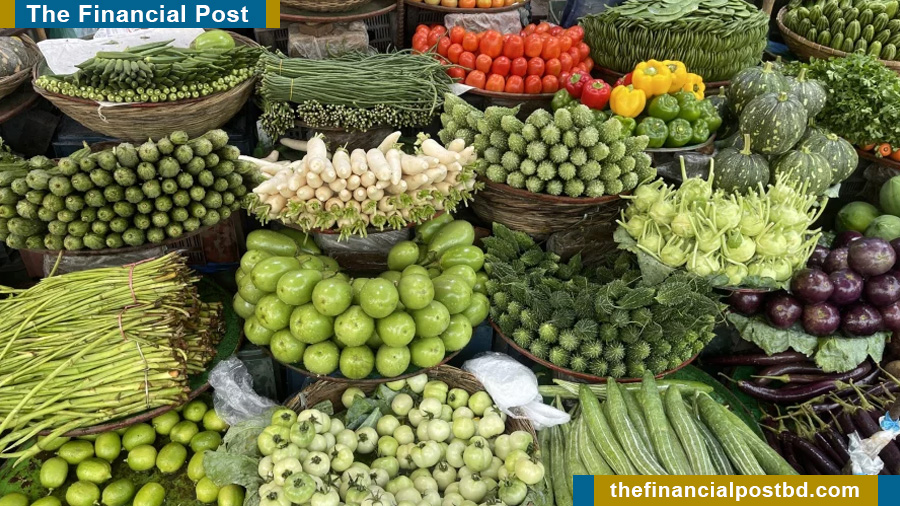Winter vegetables have begun arriving in limited quantities earlier than usual, entering a market already burdened by high prices. Supplies are now increasing, but prices have yet to fall; traders say the vegetables are newly harvested, so rates remain elevated.
However, all vegetables have been selling at high prices for more than two months. Sellers note that prices of off-season vegetables are also high as their season has ended. In effect, almost all vegetables are expensive, leaving ordinary people with little relief in the current inflated market.
A visit to the Mirpur-1 kitchen market in the capital on Friday reflected this situation.
Prices high across the board
Because winter vegetables are new, their prices are high, while non-winter vegetables are costly as their season has ended. This dual situation continues in the market, steadily narrowing the scope for relief for ordinary buyers.
People have been struggling for months due to persistently high prices, yet there appears to be little attention from the government or the relevant authorities.
On Friday, Indian tomatoes are selling for Tk140 per kg, local tomatoes for Tk140–160, green tomatoes Tk80, local carrots Tk100, Chinese carrots Tk150, long aubergine Tk100, white round aubergine Tk100, black round aubergine Tk120, hyacinth beans Tk120–140, turnip Tk100, new potatoes Tk160, spring onions Tk120, local cucumbers Tk100, bitter gourd Tk100, karela Tk100, teasel gourd Tk160, okra Tk120, hybrid pointed gourd Tk60, local pointed gourd Tk120, snake gourd Tk80, wax gourd Tk100, ridge gourd Tk100, yardlong beans Tk100–120, arum stem Tk80, radish Tk50–60, arum root Tk70–80, green chillies Tk100–120, coriander Tk200–360 depending on quality, hybrid cucumber Tk60–80, papaya Tk35–40, and sweet pumpkin Tk50 per kg.
Bottle gourd sells for Tk80–120 each depending on quality, ash pumpkin for Tk70–80, cauliflower Tk50–60, cabbage Tk50–60, and a bunch of green bananas for Tk40. A bunch of lemons is selling for Tk40–50.
Among key vegetables, 20 items are priced at Tk100 or more per kg, excluding green chillies, coriander and lemon. Eleven types fall in the Tk60–100 range, while only three remain at Tk50 or below.
Vegetable trader Md Shah Alam said, “Winter vegetables are new, which is why prices are high. When supplies increase further, prices will come down. And it is normal for off-season vegetables to become more expensive. Once peak winter arrives, I expect prices to drop significantly.”
Afzal Hossain, a shopper, said, “Vegetable prices just are not falling. How are we supposed to manage? I run a student hostel with food arrangements. I cannot absorb these extra expenses. It is not as if I raise the fees every month. My income stays the same, but my costs keep rising. That means I am losing a lot of money every month.”
Another customer said, “New or old, all vegetables are being sold at high prices. What can we do? Our pressure is increasing day by day.”
No relief in the onion market
The sudden spike in onion prices has also failed to ease. Even on Friday, all types of onions are priced above Tk100. Prices of other essentials remain unchanged.
Cross-variant onions are selling at Tk110–120 depending on size and quality—small ones at Tk110 and larger ones at Tk120. Local onions are selling for Tk120, red potatoes for Tk25, white potatoes for Tk25, Bogra potatoes for Tk30–35, local garlic for Tk80–110, Chinese garlic for Tk160–180, Chinese ginger for Tk180–200, and Indian ginger for Tk160–180, depending on quality.
An onion trader said many wholesalers stockpiled onions in hopes of higher prices, creating a shortage in the market. “Because of this shortage, prices jumped suddenly. Otherwise, they would not have risen like this. Prices do go up slightly at the end of the season, but not to this extent.”
Chicken prices slightly easier
Although vegetable and onion prices remain high, chicken prices have become somewhat manageable. However, beef and mutton continue to sell at high rates.
Beef is selling at Tk780 per kg, mutton at Tk1200. Broiler chicken are selling at Tk162–180 per kg; cock (hybrid) chicken at Tk250–280; layer chicken at Tk290–300; local chicken at Tk550 per kg. A dozen red eggs cost Tk115–120, white eggs Tk110–115, and duck eggs Tk200–210.
On Friday, broiler chicken prices fell by Tk8 per kg, cock chicken by Tk10–13, and layer chicken by Tk3. All chicken egg prices remain unchanged, though duck eggs increased by Tk20 per dozen.
In the fish market, depending on size and weight, ilish is selling for Tk900–2600, rui fish for Tk350–600, katla for Tk400–600, kalibaus for Tk400–700, prawns for Tk800–1400, kachki fish for Tk400–500, koi fish for Tk250–1000, pabda for Tk500–600, shing fish for Tk400–1200, tengra for Tk600–800, bele for Tk900–1200, meni fish for Tk600–800, boal for Tk800–1200, and rupchanda for Tk1100–1400 per kg.
Grocery prices unchanged
As on previous days, grocery store prices remain unchanged.
On Friday, packaged polao rice is selling at Tk155 per kg, while loose polao rice varies between Tk90 and Tk130 per kg, depending on quality.
Small red lentils are priced at Tk155 per kg, coarse red lentils at Tk90 per kg, large moong dal at Tk140 per kg, small moong dal at Tk170 per kg, khesari dal at Tk100 per kg, chickpea lentils at Tk115 per kg, gram (chhola) at Tk110 per kg, and mashkalai dal at Tk180 per kg.
Bottled soybean oil is selling at Tk198 per litre, while loose soybean oil is Tk172 per litre.
Branded ghee in tins is priced between Tk1,450 and Tk1,550, and loose ghee is selling at Tk1,250.
Packaged sugar is Tk110 per kg, loose sugar Tk95 per kg, two-kilogram packs of flour (maida) are Tk130, and two-kilogram packs of atta are also Tk130. Loose mustard oil is selling at Tk220 per litre.
Among spices, cardamom is priced at Tk4,750 per kg, cinnamon at Tk500, cloves at Tk1,280, white pepper at Tk1,350, and black pepper at Tk1,180 per kg.
FP/MI

